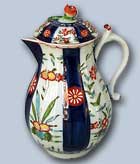 The English manufacturers of porcelain in the C18th followed in the
steps of the French in that the vast majority of porcelain made was of the soft paste type. Soft paste porcelain is porcelain made to a
formula other than the recipe for true or hard paste porcelain which
was first discovered by the Chinese about a 1000 years ago, and
successfully rediscovered by Meissen about 1710. Hard paste is a
mixture of kaolin and petunse, or china clay and china stone, mixed
and fired to a temperature of about 1350C degrees.
The English manufacturers of porcelain in the C18th followed in the
steps of the French in that the vast majority of porcelain made was of the soft paste type. Soft paste porcelain is porcelain made to a
formula other than the recipe for true or hard paste porcelain which
was first discovered by the Chinese about a 1000 years ago, and
successfully rediscovered by Meissen about 1710. Hard paste is a
mixture of kaolin and petunse, or china clay and china stone, mixed
and fired to a temperature of about 1350C degrees.
An alternative formula or soft paste was first made in Europe by
the Medicis in Florence in 1575, and later made in France from the
latter part of the C17th at Rouen. Then in the C18th by St Cloud,
Mennency, Chantilly, Vincennes and Sevres etc. These soft pastes all
included a fair proportion of glass in their formulas and produced for
the French some magnificent porcelain.
The English started making porcelain rather late compared with
Europe, and several of the English factories used the glassy type of
soft paste. In seeking to improve the recipes two other basic types of
soft paste porcelain were made in England. One type used soapstone
(soapy) in the mix and the other used bone ash (bony). Thus the three
basic English can loosely be called glassy, soapy or bony.
In the main it can be said that all English C18th factories used
soft paste, but there are three main exceptions, and these are the
factories of Plymouth , Bristol and New hall all using a hard paste
mixture. Towards the end of the C18th when the New Hall patent expired
many factories started experimenting with their formulas and tried to
better their product, and one often sees references to "hybrid
hard paste" in the late 1790s and early 1800s.
Into the early years of the 1800s New hall continued with its hard
paste and Worcester with their soft paste but gradually the English
factories swung to bone china. English bone china is said to have been
first developed by Josiah Spode around 1800 and is a mixture of hard
paste and bone ash and this is still being made by the great English
factories of today.
Recommended reading:
- A Collectors History of British Porcelain by John & Margaret
Cushion (A.C.C.)
- Eighteenth Century English Porcelain by Geoffrey Godden (
Granada)
- Encyclopaedia of British Porcelain Manufacturers by Geoffrey
Godden (B & J)
- Staffordshire Porcelain by Geoffrey Godden et al ( Granada)
- A very good little book about porcelain over 100s of years and
from around the world is a Pelican book by George Savage :
Porcelain Through The Ages
Factory Marks:
Probably less than 50% of all English porcelain and pottery from
the C18th and C19th has a factory mark therefore one has to learn to
look for further signs. Indicators to be looked for in identifying a
piece of porcelain include the type of paste, the shape, the glaze,
the colours used (either under or over glaze) , the mouldings ,handle
and finial forms etc. The sum total of these observations often
suggest a certain factory and then the mark, if any, should confirm
the observations rather than the mark itself being the sole arbiter of
the items origins. Of course itís not at all easy and many pieces
remain unattributed.
Most English marks are reliable but one should be careful, for
instance, of Chelsea "gold anchor" type marks which appear
on some French C19th hard paste copies of Chelsea. Also a Meissen type
crossed swords mark was sometimes used by four English factories and a
Worcester open crescent mark can be found on Coalport bone china
copies of Worcester porcelain and also occasionally on Lowestoft.
These are just a few examples of mistakes that can be made in putting
too much reliance on the mark.
Books on Marks:
Encyclopaedia of British Pottery and Porcelain Marks by Geoffrey A.
Godden

 The English manufacturers of porcelain in the C18th followed in the
steps of the French in that the vast majority of porcelain made was of the soft paste type. Soft paste porcelain is porcelain made to a
formula other than the recipe for true or hard paste porcelain which
was first discovered by the Chinese about a 1000 years ago, and
successfully rediscovered by Meissen about 1710. Hard paste is a
mixture of kaolin and petunse, or china clay and china stone, mixed
and fired to a temperature of about 1350C degrees.
The English manufacturers of porcelain in the C18th followed in the
steps of the French in that the vast majority of porcelain made was of the soft paste type. Soft paste porcelain is porcelain made to a
formula other than the recipe for true or hard paste porcelain which
was first discovered by the Chinese about a 1000 years ago, and
successfully rediscovered by Meissen about 1710. Hard paste is a
mixture of kaolin and petunse, or china clay and china stone, mixed
and fired to a temperature of about 1350C degrees.